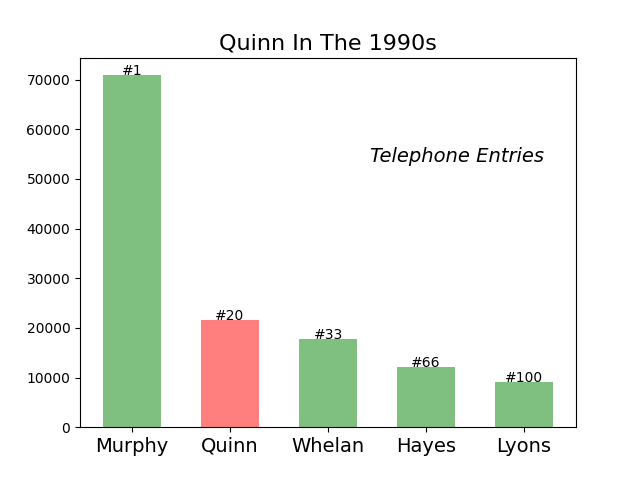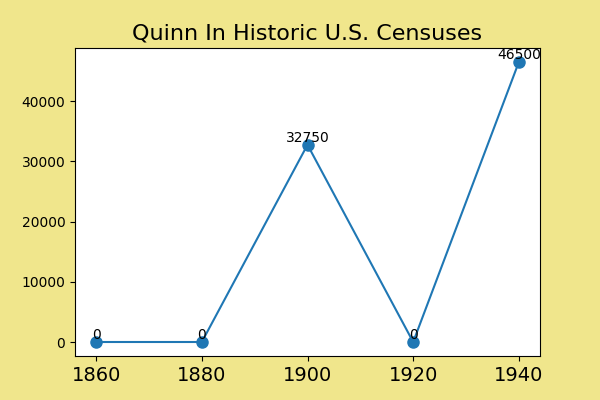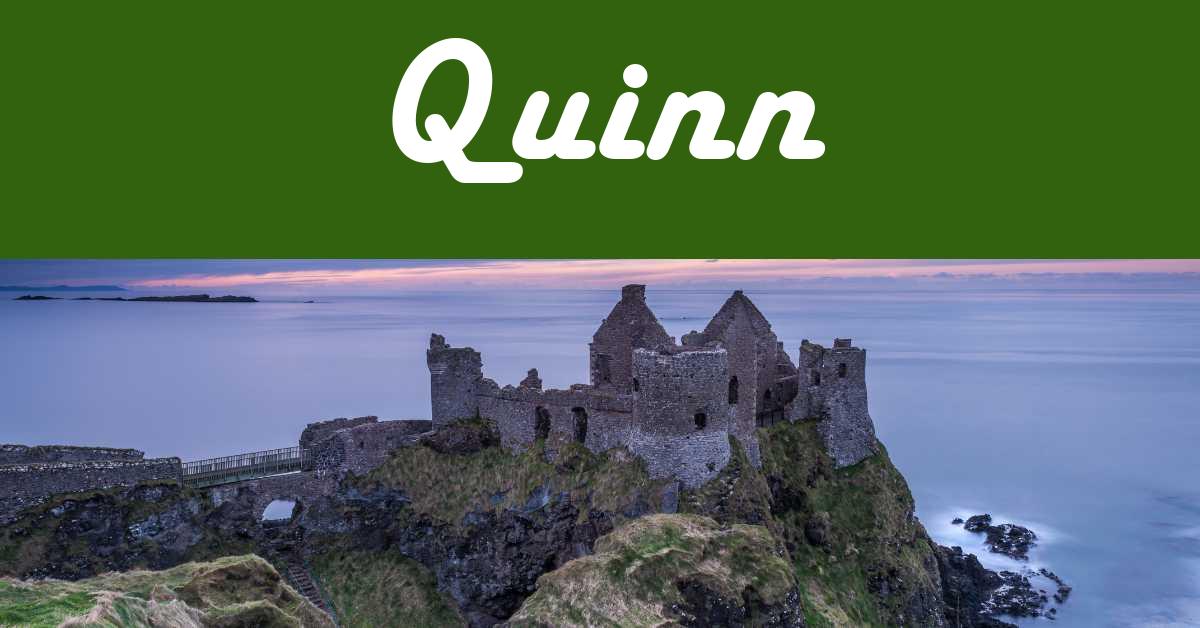This article looks at how common Quinn is as a last name in Ireland and the United States from the 19th century to the present day.
You’ll learn the meaning and origins of the Quinn surname while exploring some notable and famous people that held it.
I use census records, emigration lists, and military archives to uncover fascinating patterns. If you’re studying your genealogy, check out my sources at the end of the post so you can do your own research.
How Common Is Quinn As A Surname In Ireland?
Detailed current statistics about surnames are not publicly released by the Irish government. Instead, they offer the ten most frequently occurring surnames among newborns in the previous year. Quinn
However, an Irish genealogist studied the top one hundred surname numbers in Ireland between 1992 and 1997. Seán Murphy based his research on telephone books. This isn’t as accurate as a census but gives a good approximation.
Quinn was ranked 20 in the top one hundred names in this decade with a total of 21,500 entries.
This graphic shows how it ranks compared to the 1st, 33rd, 66th, and 100th entries in the survey:

Quinn In The Early 1900s
The only complete Irish censuses that are available to the general public are those from the years 1901 and 1911. They offer two detailed snapshots of the population.
Some records exist from earlier censuses, but most of the documents are lost to history. So, we’ll focus on the turn of the century.
I used online archives to calculate the total numbers by surname. I consider these estimates due to some percentage of transcription errors. So, I’ve rounded the numbers to the nearest fifty.
There were 15,950 residents named Quinn on the island in 1911.
Ten years earlier, Quinn had about 15,850 residents in the 1901 census.
Population Estimates In The 1890s
A study of Irish surnames was conducted in 1890 by the head of the Civil Registrations Office. It was published as a “Special Report on Surnames In Ireland.”
The survey estimated that there were about 18,200 people named Quinn in the country.
Emigration To America After The Irish Famine
The Irish have historically emigrated to Britain, the United States, Canada, and Australia. They were motivated by multiple factors, including social unrest, economic desperation, and hunger.
The peak of this migration was driven by what’s known as the Great Irish Famine, a devastating event spanning from 1845 to 1852. Potato blight had a catastrophic effect on Ireland, wiping out the primary food source for a significant portion of the population.
I reviewed the Quinn name in the shipping passenger lists arriving in New York during this period. The departures were from both Ireland and England.
This picture shows how the numbers rose and fell in the years after the famine:

How Common Is Quinn As A Last Name In The U.S.?
Based on the 2010 U.S. census, the name Quinn ranks about 422 among Irish names in America with 76,986 bearers.
Although the 2010 census has exact numbers and rankings, the rank I assign here is my estimate. If you’re curious about how I got there, here’s a brief explanation…
Estimating Rank In The United States
Historically, some Irish families with Gaelic surnames took English-sounding names as translations under the influence of colonization.
As these names also have English origins, they will have been brought to the United States by both British and Irish immigrants. Because the census doesn’t ask about specific European origin (e.g. England vs Ireland), it’s impossible to identify the proportion with Irish heritage.
I reviewed the census to identify which names are predominantly Irish in origin. In order to estimate the relative rankings of “Irish” names, I’ve mostly excluded surnames that have varying origins.
Quinn In Historic Times
In a country as young as the United States, tracking the popularity of a surname over time can be fascinating. This reflects other demographic shifts across the country in addition to immigration. Higher child mortality rates and longer life expectancy are just two factors.
The historic census records have been transcribed and digitized. I used online archives to run counts of surname populations.
But the totals can’t be exactly accurate due to transcription errors. So, I’ve rounded the numbers to the nearest 50 in the graph below.
This picture shows the numbers every twenty years from 1860 to 1940:

These are the numbers in the graph:
- 1860: 0
- 1880: 0
- 1900: 32,750
- 1920: 0
- 1940: 46,500
Quinn In World War II
Approximately 8.3 million men and women joined the United States Army during World War II. Many had Irish ancestry. Some had been born in Ireland before leaving the country.
There were registration records for 2,944 soldiers named Quinn who enlisted between 1938 and 1946.
There were 55 who were born in Ireland.
Quinn Surname: Meaning And Origin
Quinn
Quinn comes from the Gaelic surname Ó Cuinn, which means “descendant of Conn”.
The personal name Conn is derived from the Irish word ceann, which literally means the head. This term also refers to a chief.
Famous Or Historic People Named Quinn
Here are some notable people with the family name:
- One early prominent family were the Quinns of Thomond in the late tenth century. They held a region in what is now County Clare.
- Frances Quinn (1845 – 1872): born in Ireland, Frances Quinn’s parents emigrated to Illinois in 1848. Educated in a convent, Frances decided to join the Union Army during the Civil War disguised as a man.
- Edmond Quinn (1868 – 1929): an American painter and sculptor whose works include the statue of Edwin Booth in Gramercy Park and Victor Herbert in Central Park.
Sources

External Research
The Ireland 1990s estimates are from Seán J. Murphy’s research paper.
The population estimates of 1890 are based on the “Special Report on Surnames in Ireland“, published in 1909.
The population figures for the 2010 U.S. Census come from a file provided by the U.S. Census Bureau.
Internal Research
Some of the population numbers are based on my own research and calculations using online archives. I’ve rounded those numbers to the nearest 50 to account for transcription errors and other technical issues with online databases of this type.
The Irish census estimates for 1901 and 1911 are my calculations based on the Irish National Archives
I plotted the emigration figures from 1845 to 1854 based on calculations from the archives of the New York Passenger Lists (1820-1957).